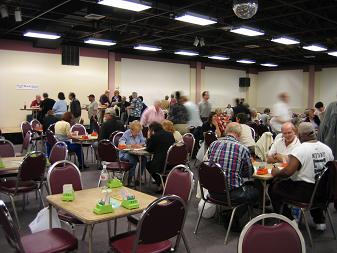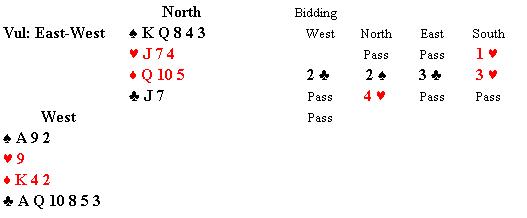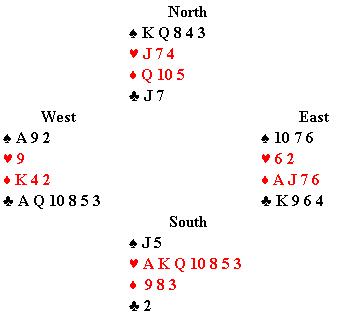
About once in a blue moon, when Dan can’t find anyone else, he scrapes the bottom of his Rolodex and invites me to be his partner in a duplicate bridge tournament. The last time I played any form of duplicate bridge was when I partnered with him in a friendly team game three years ago at the Elks club. We lost to some long-in-the-tooth retirees who in all candor weren’t very good (what does that make us?). Although Dan is a perfect gentleman, he is very competitive, and my frequent and egregious mistakes must have bothered him. So I was surprised when he invited me to play in the sectional tournament last weekend. Because I value his friendship and his season tickets to Stanford games, I accepted his offer.
Duplicate bridge is so named because the hands are duplicated, preserved, and played at other tables. In games of chance such as rubber bridge or poker, one can quickly lose interest if the cards are poor. In duplicate bridge other pairs hold the same cards that you do, and you are given points for every pair that you outperform. Each hand, whether a part score (not many points at stake in the bridge scoring system) or a slam (thousands of points), carries the same weight, so one’s concentration cannot flag.
In high school I became bored with chess, and my buddies and I---you know, the ones with the pocket protectors and slide rules—took up contract bridge. I thought I was pretty good because I could solve problems in the daily Goren or Sheinwold columns. But against real people I didn’t fare too well, probably because I had the social intelligence of a doorstop (good SATs, poor table manners). In college I hung out with guys who were regular tournament junkies, and, after two years of weekly play at the local club, accumulated about 20 master points.
The
American Contract Bridge League, whose membership I have let lapse, awards master points for winning or placing in tournaments. At the local club one can win a master point for finishing first. But one must go to the regional and national tournaments, where the quantity and quality of competition are much greater, to garner the big awards and be a ranked player. In order to be a “Life Master” one needs 300 master points, and I know individuals who hold thousands of points. Playing bridge with these folks is about as pleasant as shooting a round with a scratch golfer.
Despite the ACBL’s decades-long recruiting effort, the average age of its members has been rising steadily; the ACBL’s roster and that of the AARP are nigh indistinguishable. One technique that tournament sponsors use to make the game less intimidating for new players is stratifying the flights, that is, prohibiting the higher- ranking players from participating in certain games. [
Update - March 17th: according to the
New York Times (registration required), the ACBL's recent efforts have met with success. Bridge has become trendy.]
In the San Mateo sectional last Saturday I thought I would have a chance to do well if I could get into the under-200 game, but because Dan had too many points, we had to move up to the under-500 game, which meant that we would be facing some Life Masters.
We met forty-five minutes early to go over bidding conventions, and, after painstakingly completing the convention card on which bidding methods are disclosed to the opponents, I realized that bidding had moved far beyond the natural style with which I was familiar. (“Natural” means that there are a lot fewer bidding sequences to memorize, and bidding a suit meant that you had it, that is, a bid of one spade denotes possession of a spade suit.) At that point Dan presented me with the gift of a book that covered the latest bidding conventions. I thanked him for his thoughtfulness, much as I thank my wife when she points me to an article that dispenses advice on how to be a better husband / father / provider.
This was the first hand of the night, and I sat in the West position:

My opening lead was the passive ♥ 9, because I didn’t want to give a trick away. South won with the ♥ 10, then drew another round of trumps with the ace, partner following. A low spade to the king, which I ducked, then a spade back to declarer’s jack, which I took with the ♠ A; partner followed up the line with the six and seven of spades.
I cashed the ace of clubs, and partner signaled with the nine. Some players always signal the count—in such a case the nine would have meant an even number of clubs—but in our brief discussion before the game Dan said that a high card would show encouragement. We were clearly not going to defeat the contract, because declarer needed the ace of diamonds for his opening bid (the ace, king, and queen of hearts, plus the jack of spades, only came to ten high card points and one normally needs 13 to open), so the goal became to minimize his overtricks. With three spade tricks staring at me in the dummy, plus five trumps in the South hand, plus the ace of diamonds, the only hope was to get another club to hold declarer to ten tricks, so I led the queen.
Disaster! Declarer ruffed, and claimed the rest of the tricks. He
didn’t have the ace of diamonds. This was the complete hand:

I could have set the contract by two tricks if I had led a diamond. Partner sympathized and said it was a tough decision. It was going to be a long night.
...to be continued.... © 2004 Stephen Yuen